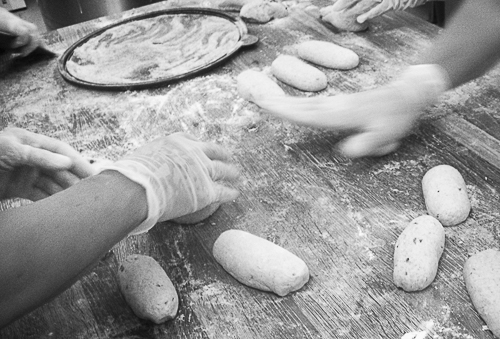Besides going to a chocolate-making course, I also joined a bread-making course at Skog bakery workshop where the owner, Anne Lise Tharaldsen works as both baker and confectioner. Actually, it felt good going to a bakery course at this bakery since she’s using spelt, a type of rye called svedjerug and emmer flour from Økologisk spesialkorn, one of whose owners I had already met at a field trial of growing cereals. The farmers, who are cultivating the cereals from which Anne Lise is using flour to make her products, let their harvests grow slowly without using artificial fertilisers. According to Anne Lise, the resulting flour is easily workable, all nutrients are present and it gives tasty products.
As participants at the course, we should make sourdough bread based on flour from spelt, besides mash from a local brewery The fermentation starter or mother dough, which is used to leaven the breads, was reused. In fact, Anne Lise keeps it alive by giving it flour occasionally. She weighed the required amount of flour and poured it into a kneader. After having added water and the mother dough, she started the kneader, freeing us from the long and arduous work of kneading the dough.
While waiting for the dough to finish, Anne Lise showed us her bakery, which looked very tidy and modern. Instead, she told us that the building in which her bakery was situated, had been built recently, while she had bought the kneader, the bakery oven and various bits and pieces second-hand. She’s very concerned about preserving biological diversity and she has included a ladybird in her logo signifying that ladybirds eat aphids if the plants aren’t sprayed with insecticides. She’s also using organic butter from Rørosmeieriet, organic cocoa butter and cocoa powder.
When the dough was finished, we took it out of the kneader and cut it into parts weighing what was required to make one bread or one bread roll. Finally, we shaped the dough manually and put it into moulds, looking like baskets consisting of concentric circles. After having left the pieces of dough in a chamber for leavening for some time, we took them out again and put them in an oven by means of a long-handed shovel. After some time, we took the breads and bread rolls out of the oven again, but not before measuring the temperature inside some of them. If the internal temperature was too low, they had to stay longer in the oven. Some of the more experienced students also knocked on the base of the bread, listening for a special sound, indicating that it was ready. Interestingly, the bakers at the Porta confectionery and bakery in the town of Gonnosfanadiga in Sardinia did the same.
Finally, after having paid Anne Lise the course fee, we could go back home with a selection of delicious breads and bread rolls, all of which were tasty for the approximately two weeks it took to eat all of them.

